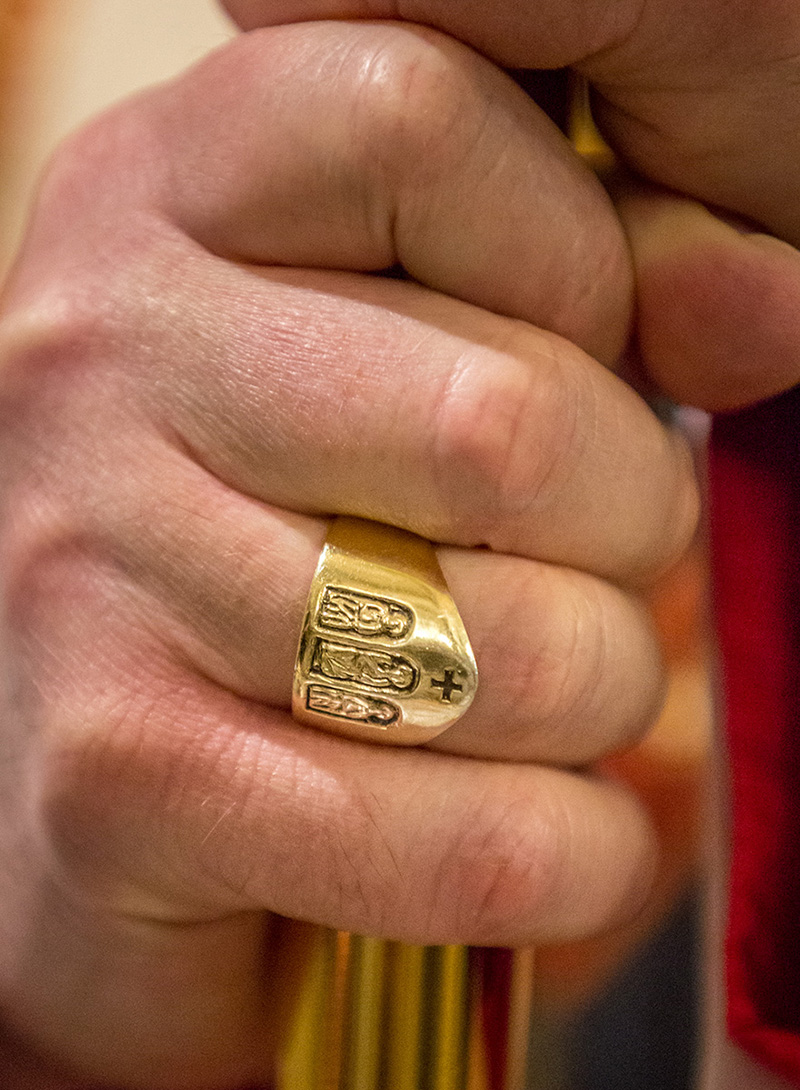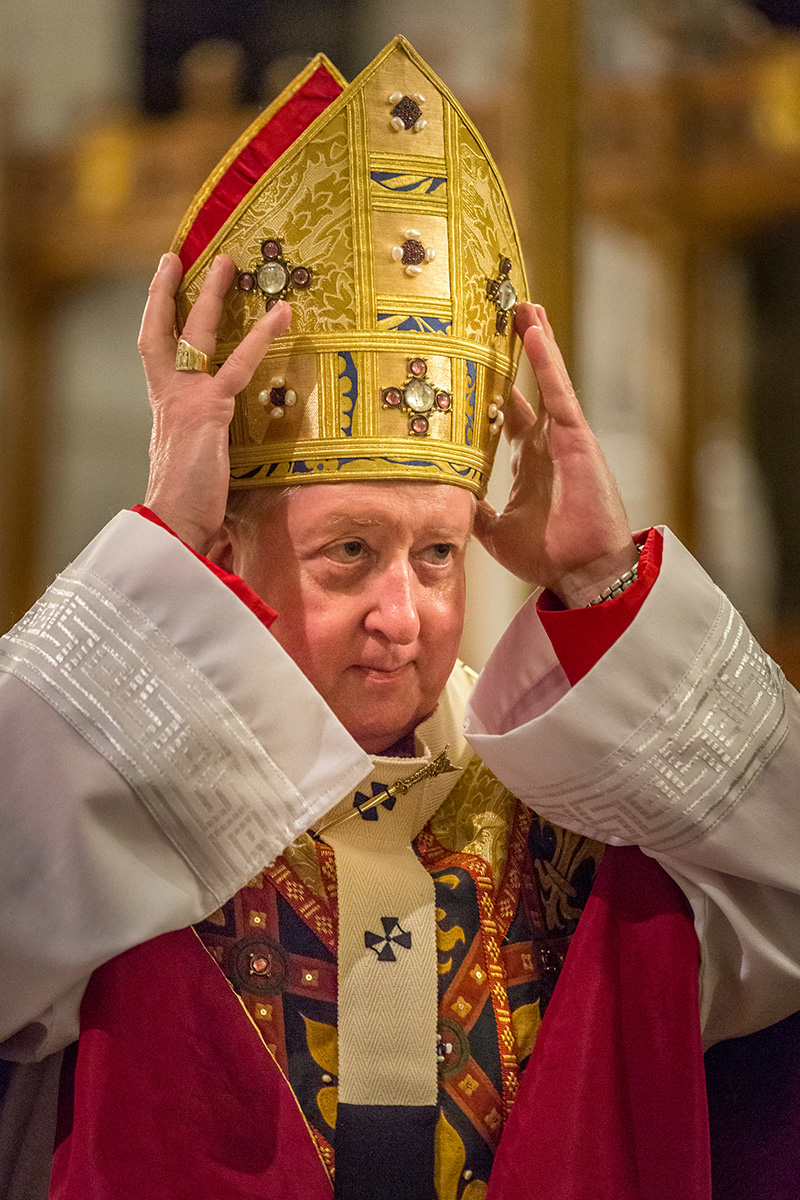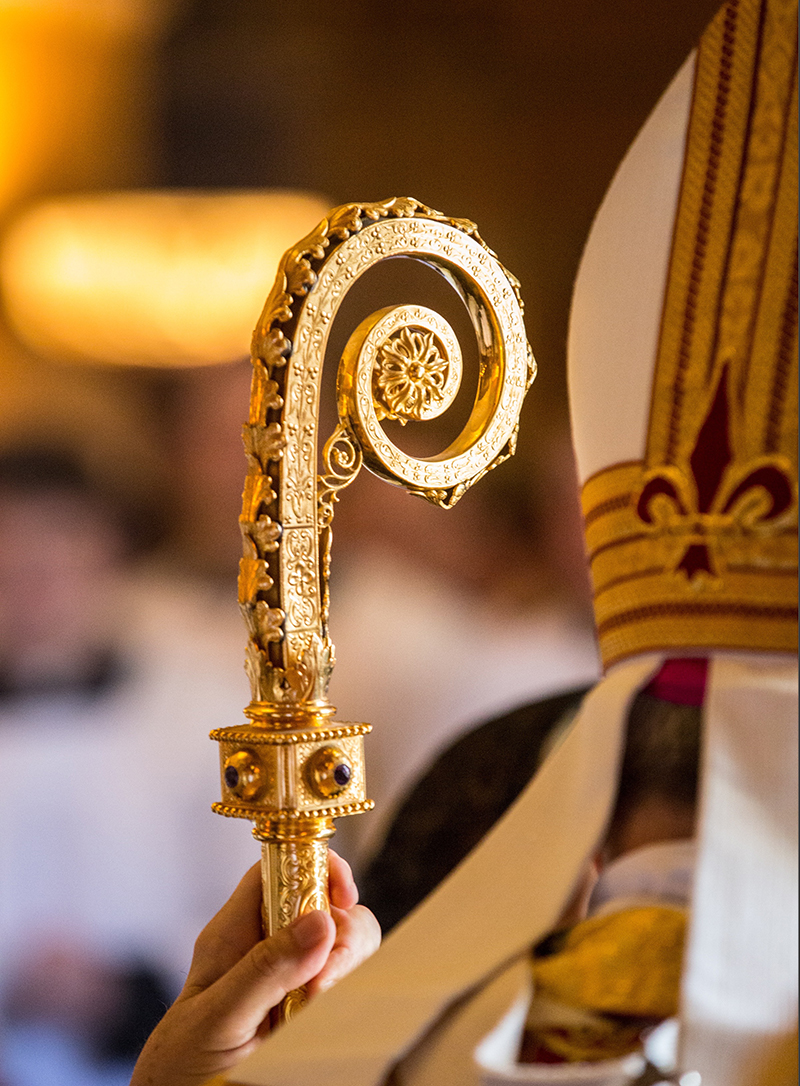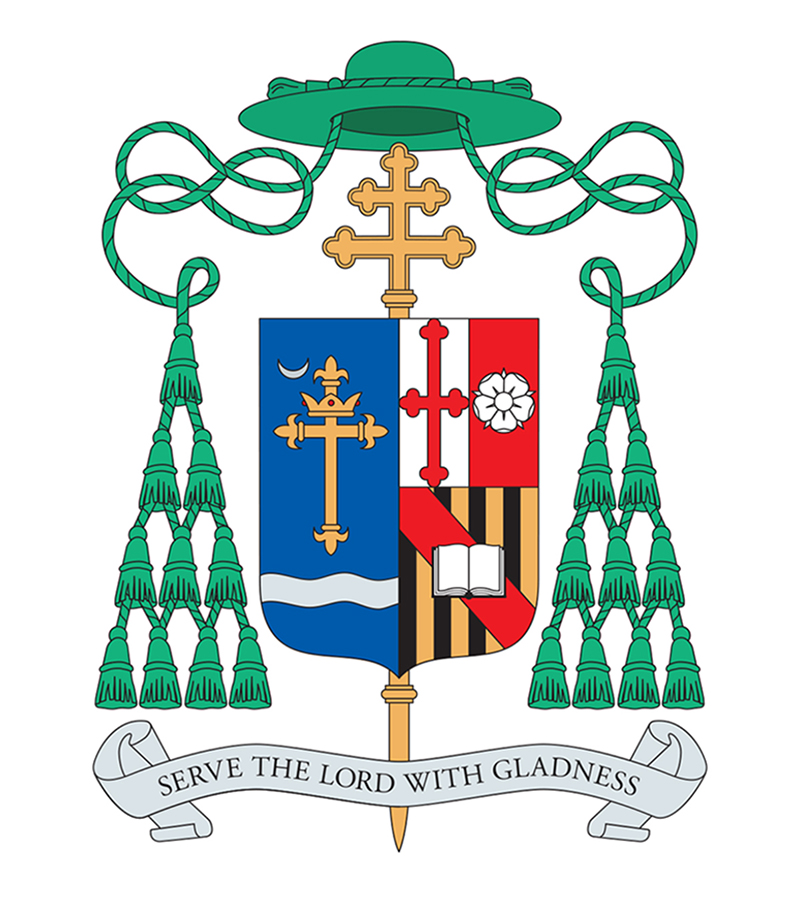Bishops wear distinctive symbols or insignias, also called regalia, which communicate to the faithful and others their special place within the Church. The Order of the Bishop, which grants to those ordained to this rank the fullness of the Sacrament of Holy Orders, is symbolized primarily the ring, miter and the crosier (or pastoral staff).
 Photo Credit: Lisa Johnston
Photo Credit: Lisa JohnstonThe Pallium
The pallium is a woolen band that the heads of archdioceses wear around their shoulders over their Mass vestments. It is given to an archbishop by the pope as a sign of their unity with him as they minister to a part of the Catholic “flock.” Archbishop Rozanski received the pallium at his installation Mass Aug. 25.
A pallium measures about 3 inches wide and has a 14-inch strip hanging down the front and the back. The strips are finished with black silk, almost like the hooves of the sheep the archbishop is symbolically carrying over his shoulders.
 Photo Credit: Lisa Johnston
Photo Credit: Lisa JohnstonThe Ring
The bishop’s ring primarily symbolizes discretion, since rings were used to seal private documents and the conjugal nature of the relationship between the bishop and the Church. The ring represents the symbolic marriage between the bishop and the Church.
Archbishop Rozanski’s ring is a replica of the ring that Pope Paul VI gave to each bishop participating in the Second Vatican Council. The ring is in the shape of a bishop’s miter, with an image of our Lord flanked by Sts. Peter and Paul on either side.
A bishop receives a ring during the Rites of Ordination, which Archbishop Rozanski received when he was ordained a bishop in Baltimore. Upon handing over the ring to the newly ordained bishop, the principal ordaining bishop says, “Receive this ring, the seal of fidelity, adorned with undefiled faith, preserve unblemished the bride of God, the Church.”
 Photo Credit: Lisa Johnston
Photo Credit: Lisa JohnstonThe Miter (the bishop’s hat)
The miter is a headdress, which points upward toward heaven and can be compared to the laurel wreathes given to victorious athletes. It has become a symbol of how the bishop will be received in heaven with his whole flock and rewarded for his fidelity. 2 Timothy 4:7-8 says, “I have competed well; I have finished the race; I have kept the faith. From now on the crown of righteousness awaits me, which the Lord, the just judge, will award to me on that day, and not only to me, but to all who have longed for His appearance.”
During the Rites of Ordination the principal ordaining bishop places a miter on the head of the new bishop while saying: “Receive the miter, and may the splendor of holiness shine forth in you, so that when the chief shepherd appears, you may deserve to receive from him an unfading crown of glory.”
 Photo Credit: Lisa Johnston
Photo Credit: Lisa JohnstonThe Crosier (also called the pastoral staff)
Each bishop is a symbol of Christ the Good Shepherd. It is Christ who the bishop is trying to model himself after and it is Christ who each bishop strives to imitate and model for the flock. The crosier also symbolizes the responsibility that the bishop has in leading all to Christ. Sometimes the crosier will be used to scare off the wolves that want to hurt the flock, and other times it can be used to pull the sheep back if they begin to wander off. The crosier tells us that the bishop is a leader after Christ’s own heart.
The last symbol received by the newly ordained bishop is the crosier. The principal ordaining bishop says: “Receive the crosier, the sign of your pastoral office, and keep watch over the whole flock in which the Holy Spirit has placed you as bishop to govern the Church of God.”
The Pectoral Cross
While not part of the Rites of Ordination, another symbol of the bishop, and a relatively new addition, is the pectoral cross. It is called pectoral because it is worn over the pectus or breast of the bishop, close to his heart, and its use began between the 17th and 18th century.
Traditionally, the bishop will take the cross, kiss the cross and while placing it over his neck say the following short prayer, “Munire me digneris.” This is a prayer, which is asking the Lord for three things,
• For protection against all who wish him harm
• To be able to always remember the Passion of Christ
• Keep in mind the success of those who have professed their faith in Christ
Coat of Arms

A bishop’s coat of arms is distinguished by a sign of his rank, an ecclesial hat. That hat, placed over the shield, was worn in processions, as late as 1870. The hat is low-crowned, flat, and wide brimmed. The hat is green and hanging from it are twelve green tassels, six on each side. There’s also a processional cross above the shield. The cross on a bishop’s coat of arms has one bar; an archbishop’s cross has two. The design of the shield itself differs from bishop to bishop.
The Bishop’s Chair
The bishop’s chair or throne in his primary church is called a cathedra, and this is why this primary church is called a cathedral. From this chair, the bishop presides at Mass and other solemn celebrations. The bishop is always the leader of prayer in his diocese. Because of this, when the Rites of Ordination of a Bishop take place in the bishop’s cathedral church, and he is to become the Ordinary Bishop of that Diocese, he is led to this chair after having received the symbols of his office as bishop. This symbolizes that the bishop has taken his place as the ordinary of the diocese. Similarly, for the installation of an archbishop, he will take his place at the cathedra.
Originally, this chair was the place from which the bishop would authoritatively preach and teach to those present in the church. Because of this, the bishop’s chair, or cathedra, is a sign of his authority to proclaim the Good News of Jesus Christ and to teach the great truths of our faith to the Body of Christ, the Church. The bishop is the primary preacher, teacher and catechist of the diocese. Finally, the bishop’s chair also represents the unity of faithful around that which is taught by the community’s good shepherd, the bishop.